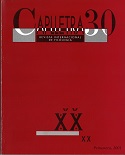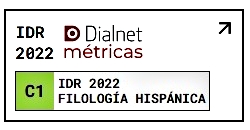Els derivats d'«esse» i «stare» en les llengües romàniques
DOI:
https://doi.org/10.7203/caplletra.30.4961Paraules clau:
verb llatí «esse», verb llatí «stare», llengües romàniques, anàlisi contrastiva, Resum
Resum
This paper presenta a contrastive analysis of the Romance verbs derived from ESSE and STARE. The lexical and syntactic
characteristics of these verbs in Latin and their locative and atributive uses clearly contrast with actual Romance uses. This contrast
highlights the variable extension of the verbs derived from STARE assuming the space of those derived from ESSE.One extreme of the
clyne is represented by the Hispanic languages (i.e., Spanish, Portuguese and Catalan), which have developed more uses and thus
extended further the STARE forms. On the opposite extreme, there is French, which has no STARE uses. In between, there are Occitan,
Sardinian, Italian and Romanian, which include some forms derived from STARE, but their extension is inferior to the extension reached in the Hispanic languages. The analysis focusses on the factors that have interacted and influenced on this extension of use and points to the present tendencies.
 Descàrregues
Descàrregues
Descàrregues
Publicades
Com citar
-
Resum530
-
PDF296
Número
Secció
Llicència
L’autor o autora que adrece un treball a la redacció de Caplletra perquè siga publicat ha de ser la persona titular legítima dels drets d'explotació. La legitimació per a la publicació del treball ha d’incloure també les imatges, les taules, els gràfics i altres materials que puguen complementar el text, amb independència de si n'és l'autor o autora.
Copyright. Quan publica el treball en la revista, l'autor o autora cedeix a Caplletra. Revista Internacional de Filologia els drets d'explotació (reproducció, distribució i comunicació pública), tant per a l'edició impresa en paper com per a la versió electrònica, que serà accessible mitjançant la xarxa Internet.
Tots els treballs publicats en Caplletra es troben sota una llicència Creative Commons del tipus Reconeixement-NoComercial-SenseObraDerivada 4.0.
RESPONSABILITAT
Caplletra. Revista Internacional de Filologia no s'identifica necessàriament amb els punts de vista mantinguts en els treballs que publica.
Caplletra. Revista Internacional de Filologia declina tota responsabilitat derivada de qualsevol vulneració eventual dels drets de propietat intel·lectual que poguera ser duta a terme pels autors o autores.






